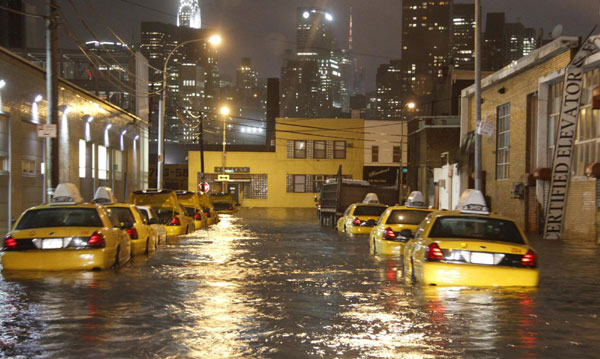Superstorm Sandy kills 40, millions without power
Updated: 2012-10-31 07:35
(Agencies)
|
||||||||
NEW YORK - The misery of superstorm Sandy's devastation grew Tuesday as millions along the US East Coast faced life without power or mass transit for days, and huge swaths of New York City remained eerily quiet. The US death toll climbed to 40, many of the victims killed by falling trees, and rescue work continued.
The storm that made landfall in New Jersey on Monday evening with hurricane force cut power to more than 8.2 million across the East and put the presidential campaign on hold just one week before Election Day.
New York was among the hardest hit, with its financial heart closed for a second day. The storm caused the worst damage in the 108-year history of the city's subway system, and New York City Mayor Michael Bloomberg said it could be four or five days before the biggest US transit system was running again.
|
 A street in Queens Borough of New York city is flooded after superstorm Sandy battered the the US East Coast on Oct 29, 2012. [Photo/Agencies] |
"This was a devastating storm, maybe the worst that we have ever experienced," Bloomberg said.
But the full extent of the damage in New Jersey was being revealed as morning arrived. Emergency crews fanned out to rescue hundreds.
A hoarse-voiced New Jersey Gov. Chris Christie gave bleak news at a morning news conference: Seaside rail lines washed away. No safe place on the state's barrier islands for him to land. Parts of the coast still under water.
"It is beyond anything I thought I'd ever see," he said. "It is a devastating sight right now."
The death toll from Sandy in the US included several killed by falling trees. Sandy killed 10 people in New York City. It also killed 69 people in the Caribbean before making its way up the Eastern Seaboard.
Airlines canceled more than 15,000 flights. New York City's three major airports remained closed.
Some bridges into the city reopened at midday, but most major tunnels and bridges remained closed, as were schools and Broadway theaters.
The storm sent a nearly 14-foot (4.27-meter) surge of seawater, a record, coursing over Lower Manhattan's seawalls and highways and into low-lying streets. The water inundated tunnels, subway stations and the electrical system that powers Wall Street and sent hospital patients and tourists scrambling for safety. Skyscrapers swayed and creaked in winds that partially toppled a crane 74 stories above Midtown. A large tanker ship ran aground on the city's Staten Island.

 Relief reaches isolated village
Relief reaches isolated village
 Rainfall poses new threats to quake-hit region
Rainfall poses new threats to quake-hit region
 Funerals begin for Boston bombing victims
Funerals begin for Boston bombing victims
 Quake takeaway from China's Air Force
Quake takeaway from China's Air Force
 Obama celebrates young inventors at science fair
Obama celebrates young inventors at science fair
 Earth Day marked around the world
Earth Day marked around the world
 Volunteer team helping students find sense of normalcy
Volunteer team helping students find sense of normalcy
 Ethnic groups quick to join rescue efforts
Ethnic groups quick to join rescue efforts
Most Viewed
Editor's Picks

|

|

|

|

|

|
Today's Top News
Health new priority for quake zone
Xi meets US top military officer
Japan's boats driven out of Diaoyu
China mulls online shopping legislation
Bird flu death toll rises to 22
Putin appoints new ambassador to China
Japanese ships blocked from Diaoyu Islands
Inspired by Guan, more Chinese pick up golf
US Weekly

|

|







